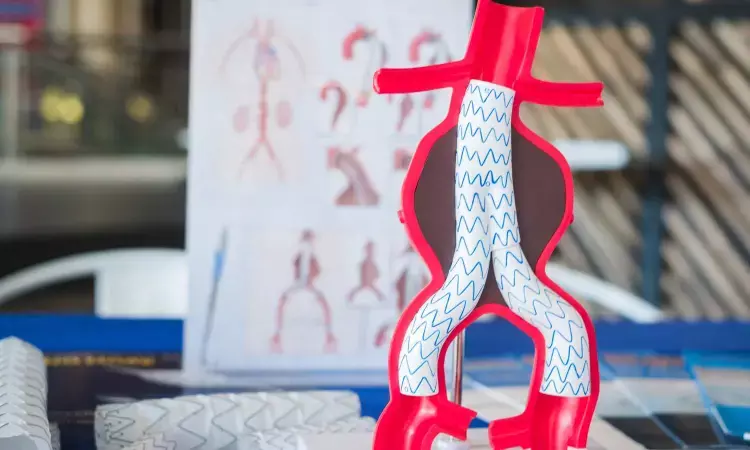- Home
- Medical news & Guidelines
- Anesthesiology
- Cardiology and CTVS
- Critical Care
- Dentistry
- Dermatology
- Diabetes and Endocrinology
- ENT
- Gastroenterology
- Medicine
- Nephrology
- Neurology
- Obstretics-Gynaecology
- Oncology
- Ophthalmology
- Orthopaedics
- Pediatrics-Neonatology
- Psychiatry
- Pulmonology
- Radiology
- Surgery
- Urology
- Laboratory Medicine
- Diet
- Nursing
- Paramedical
- Physiotherapy
- Health news
- Fact Check
- Bone Health Fact Check
- Brain Health Fact Check
- Cancer Related Fact Check
- Child Care Fact Check
- Dental and oral health fact check
- Diabetes and metabolic health fact check
- Diet and Nutrition Fact Check
- Eye and ENT Care Fact Check
- Fitness fact check
- Gut health fact check
- Heart health fact check
- Kidney health fact check
- Medical education fact check
- Men's health fact check
- Respiratory fact check
- Skin and hair care fact check
- Vaccine and Immunization fact check
- Women's health fact check
- AYUSH
- State News
- Andaman and Nicobar Islands
- Andhra Pradesh
- Arunachal Pradesh
- Assam
- Bihar
- Chandigarh
- Chattisgarh
- Dadra and Nagar Haveli
- Daman and Diu
- Delhi
- Goa
- Gujarat
- Haryana
- Himachal Pradesh
- Jammu & Kashmir
- Jharkhand
- Karnataka
- Kerala
- Ladakh
- Lakshadweep
- Madhya Pradesh
- Maharashtra
- Manipur
- Meghalaya
- Mizoram
- Nagaland
- Odisha
- Puducherry
- Punjab
- Rajasthan
- Sikkim
- Tamil Nadu
- Telangana
- Tripura
- Uttar Pradesh
- Uttrakhand
- West Bengal
- Medical Education
- Industry
Endovascular repair reduces microcalcifications in abdominal aortic aneurysms

Based on fluoride-18 uptake, endovascular aneurysm repair has been demonstrated to decrease aortic microcalcification and disease activity in patients with abdominal aortic aneurysms, says an article published in BMJ Heart.
Sodium [18F]fluoride positron emission tomography can detect aortic microcalcification and disease activity in people with abdominal aortic aneurysms. Increased consumption is linked to unfavorable clinical outcomes, including aneurysm growth. It is uncertain how sodium [18F]fluoride absorption and aortic disease activity are affected by endovascular aneurysm repair (EVAR). To examine the absorption of aortic sodium [18F]fluoride before and after treatment with EVAR, Samuel Debono and team did this investigation.
Preoperative and postoperative sodium [18F]fluoride positron emission tomography-computed tomography angiography was carried out in patients with an infrarenal abdominal aortic aneurysm undergoing EVAR in accordance with current guideline-directed size treatment thresholds in a preliminary proof-of-concept cohort study. Aortic microcalcification activity (AMA), a summary indicator of mean aortic sodium [18F]fluoride uptake, was used to evaluate regional aortic sodium [18F]fluoride uptake.
The key findings of this study were:
1. Ten subjects (mean age, 76.6 years) were recruited, and the mean aortic diameter at the time of EVAR was 57.2 mm.
2. The median interval between an EVAR and a repeat scan was 62 months.
3. The abdominal aortic AMA was greater than the thoracic aortic AMA prior to EVAR (AMA 1.88 vs 1.2; p0.001).
4. Following EVAR, sodium [18F]fluoride absorption was significantly decreased in the suprarenal, neck, and body of the aneurysms (AMA 0.62, p=0.03, AMA 0.72, p=0.02, and AMA 0.69, p=0.02) but remained unaltered in the thoracic aorta (AMA 0.11, p=0.41).
In the stented aortic segment, EVAR is linked to a decrease in AMA. According to this study, aortic sodium [18F]fluoride uptake is a potential non-invasive surrogate measure of aneurysm disease activity and implies that EVAR can affect aortic disease activity.
Reference:
Debono, S., Nash, J., Fletcher, A. J., Syed, M., van Beek, E. J. R., Williams, M. C., Falah, O., Tambyraja, A., Dweck, M. R., Newby, D. E., & Forsythe, R. O. (2023). Aortic sodium [18F]fluoride uptake following endovascular aneurysm repair. In Heart (p. heartjnl-2023-322514). BMJ. https://doi.org/10.1136/heartjnl-2023-322514
Neuroscience Masters graduate
Jacinthlyn Sylvia, a Neuroscience Master's graduate from Chennai has worked extensively in deciphering the neurobiology of cognition and motor control in aging. She also has spread-out exposure to Neurosurgery from her Bachelor’s. She is currently involved in active Neuro-Oncology research. She is an upcoming neuroscientist with a fiery passion for writing. Her news cover at Medical Dialogues feature recent discoveries and updates from the healthcare and biomedical research fields. She can be reached at editorial@medicaldialogues.in
Dr Kamal Kant Kohli-MBBS, DTCD- a chest specialist with more than 30 years of practice and a flair for writing clinical articles, Dr Kamal Kant Kohli joined Medical Dialogues as a Chief Editor of Medical News. Besides writing articles, as an editor, he proofreads and verifies all the medical content published on Medical Dialogues including those coming from journals, studies,medical conferences,guidelines etc. Email: drkohli@medicaldialogues.in. Contact no. 011-43720751


